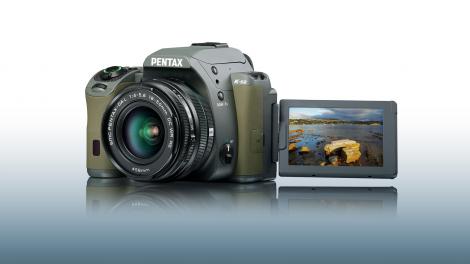
Introduction and features
Ricoh/Pentax introduced its new K-S2 relatively quickly after the K-S1 came out. However, despite the similarities in name, it’s not a replacement for the K-S1 – instead, it sits slightly above it in Pentax’s range. Internally, it shares a lot of the K-S1’s specifications, but much of the camera’s physical design and usability has been reworked.
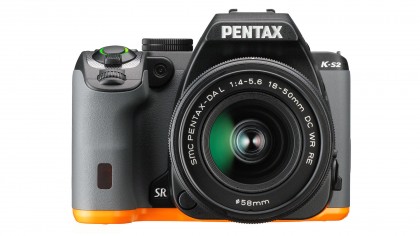
You won’t find the KS-1’s flashing lights adorning the front of the camera, but that’s not the only thing that will please enthusiast photographers. The fact is that behind all the gimmicks and flashy lights, the K-S1 was actually a decent camera, so it’s great to the K-S2 using much of the same technology in a much more serious camera.
Never mind the weather
Pentax claims that the K-S2 is the world’s smallest and lightest weatherproof camera, which should make it capable of resisting the odd rain shower or two – particularly useful for landscape and street photographers.
Ricoh/Pentax has thrown in a few other firsts here as well – at least for the brand, if not for the DSLR market as a whole. For example, this camera features a fully articulating screen (though it’s not touch sensitive). This screen uses airless gap technology which fills in the space between the LCD and its protective cover in order to improve visibility in bright light.

Another first for Pentax is inbuilt Wi-Fi and NFC, which can be used in conjunction with a free Image Sync app available for iOS and Android to both control the camera and download shots taken with it for quick uploading to social networking sites and the like.
There’s more. Pentax has introduced a new kit lens for the K-S2. It’s an 18-50mm f/4-5.6 optic, which retracts in on itself to reduce the overall size of the system when it’s in storage or when you’re carrying it around.
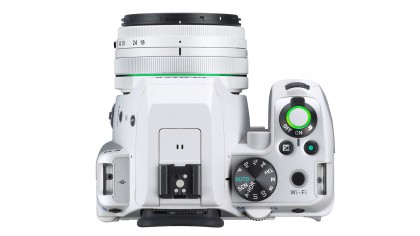
Unlike Canon and Nikon, which use lens-based image stabilizers, Pentax uses a sensor based SR (Shake Reduction) system inside its DSLRs, including the K-S2, to help reduce blur when hand-holding the camera.
Other useful features include 5.5 frames per second continuous shooting and a maximum shutter speed of 1/6000 sec – that’s a touch faster than most of its direct rivals, which offer a maximum of 1/4000 sec. The benefit of fast shutter speeds like this is not simply for freezing fast-moving subjects – you can also shoot in bright light with wide apertures to increase background blur without overexposing.
Sensor and AF system
The sensor is the same one you’ll find in the K-S1: a 20-million pixel APS-C sized sensor which features a maximum sensitivity of ISO 51200. There’s no anti-aliasing filter here, which is starting to become increasingly common and helps to maximise the detail output of the camera. In order to avoid the problems associated with this design – namely the risk of moiré patterns appearing when photographing something with fine repeating patterns – Pentax has come up with a novel and interesting solution. If see any moiré effect, you can use the camera’s anti-aliasing ‘simulation mode to retake the shot. This applies a tiny vibration to the sensor during the exposure, minutely shifting the photosites and therefore replicating the effect of a low pass filter.
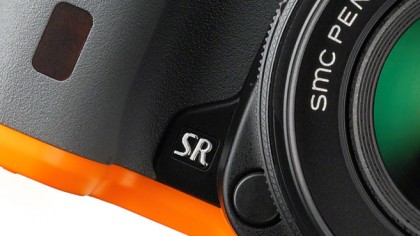
The autofocus system has 11 AF points that can be used with the K-S2, of which 9 are the more sensitive cross-type. This is not the most sophisticated on the market, and you may find the system quite coarse and noisy when using some of Pentax’s cheaper lenses which don’t have their own AF motors. The new kit lens does, however, have its own built-in DC motor.
The KS-2’s viewfinder not only offers a 100% view, but it’s also a proper glass pentaprism – cheaper DSLRs tend to use a pentamirror which offers only 95%, 96% or 97% coverage.
There’s full HD video recording, as you’d expect in an up to date DSLR, while a range of digital filters and the ability to process raw files in-camera round off the specifications list of the K-S2.
Build Quality and Handling
It’s the smallest weatherproof DSLR on the market, and the K-S2 has a diminutive size which makes it feel almost more akin to some of the larger compact system cameras on the market. Furthermore, the kit lens and some other lenses which you can buy for the system are also pretty small, making it a good choice if you’re concerned about weight and size.
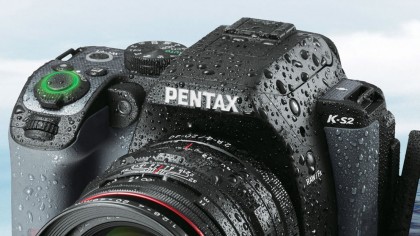
You need to hold down a small button on the side of the retracting kit lens to extend it before you can take your first shot. This can add a couple of seconds to shooting time, so if you’re planning on taking a few shots, it’s best to leave it extended. To zoom in and out, you rotate a small ring on the front of the lens – it takes a bit of time to get used to the positioning of this ring, especially as the focusing ring directly behind it is roughly the same size. At times, I found it quite frustrating, when compared to the much larger, easier to find zoom rings of other kit lenses.
Control layout
The K-S2 has quite a small grip when compared with other cameras of its kind. However, it still feels pretty comfortable in the hand, with a small indent allowing your middle finger to rest nicely. The two scrolling dials – one on the front of the grip, and the other on the rear – make changing the settings feel easy and natural.
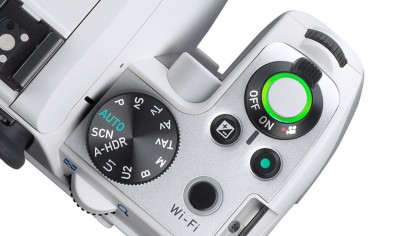
Both of the dials control a different function, depending on which exposure mode you’re currently using. In manual exposure mode, the front dial alters shutter speed and the rear dial alters aperture. If you’re working in shutter priority mode, only the front dial will work – and the opposite if you’re working in aperture priority. The good news is that if you prefer to work in a different way, you can customise how each of the scrolling dials work in different exposure modes via the main menu.
The vast majority of the KS-2’s buttons are on the right hand side of the camera, which means it’s pretty quick to make changes with just one hand. There are however, some buttons on the left side, notably the Live View button. There are a couple more on the side of the camera, including the AF/MF switch. A customisable button marked ‘Raw/FX’ allows you to choose from one of six different functions (when shooting).
One of the most useful controls on the camera is the green button on the top-plate, just behind the shutter release button. This restores certain settings (such as exposure compensation) back their defaults.
Wi-Fi and NFC
There’s also a button on top of the camera which you can hold down to activate the camera’s Wi-Fi system. Using the app and connecting to the camera from your smartphone or tablet is very easy. If you have an NFC enabled phone, you simply hold the two devices together and – if it’s the first time you’ve done that – you’ll be prompted to download the free Image Sync app. Alternatively, if you have a Wi-Fi only phone (such as an iPhone), you can download the Image Sync app from the App Store and connect to the camera’s Wi-Fi in your phones setting.
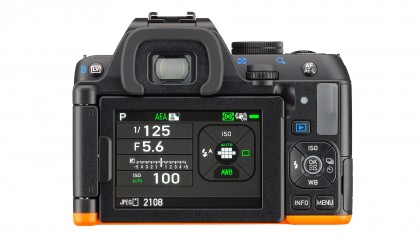
Pressing the ‘info’ button on the back of the camera gives you access to a quick menu which helps you to change certain key settings more quickly, such as Custom image, JPEG quality and metering settings. It would have been nice if you could customise this menu depending on how you like to work best, though.
Once you’re connected, the app is excellent to use. It gives you complete control over pretty much all of the camera’s settings, which is refreshing to see and genuinely useful. The only things you can’t change are mechanical, such as whether the flash is raised, or the focal length of your lens. It’s also fairly easy to transfer images across to your phone for sharing on social networks, once you get the hang of how to select and download a photo.
Although it’s nice to have a 100% viewfinder, as it is optical rather than electronic, it means that you won’t be able to see any changes made to settings until you look at the shot on the LCD afterwards.
Performance
As the K-S2 uses the same sensor and processor combination as the K-S1, I had little doubt that performance in terms of image quality would be almost identical.
Image quality is one of the best things about the K-S2’s sibling, and it continues to impress well here. I found that the JPEG images are nicely saturated with vibrant colours which pop well even when using the ‘Natural’ setting.

Click here for a full size version.

Click here for a full size version.
If you’re shooting in raw format this gives you good scope for post-production adjustment and more muted results. Our labs results also show that the K-S2 puts in a good performance for dynamic range across the sensitivity range, being reasonably close to the Nikon D5500 – this is borne out in real world shooting, too and again it gives good scope for post-capture adjustment.
You can change the way colours look direct from the camera in a couple of different ways. First of all, you can choose a different ‘Custom Image’ – all the normal options are here including Portrait, Landscape and so on, but there are also a couple of ‘out there’ choices, like Bleach Bypass and Reversal Film, which are fun to experiment with. Alternatively, you can use one of the Digital Filters, which are generally a little wackier, but also worth a look.

Click here for a full size version.

Click here for a full size version.
Sharpness and noise
As we saw before with the K-S1, the K-S2’s sensor can resolve a good amount of detail, thanks in part to the removal of anti-aliasing filter. At 100% magnification on-screen JPEG images taken at low sensitivities appear very sharp and there’s very little image smoothing. Even when looking at images shot at higher sensitivities, such as ISO 3200, detail is still resolved well, and at normal printing and web viewing sizes the overall impression of detail is fantastic.
The camera’s Shake Reduction system also works well to combat blur in images, meaning you can use it one handed, or shoot quickly without worrying too much if the camera is 100% steady.
It’s clear that the camera applies a fair amount of noise reduction when shooting at high sensitivities, as it’s possible to see speckling and chroma noise in the raw files. This gives you good scope for applying your own noise reduction to raw files.
It’s possible to shoot at a maximum sensitivity of ISO 51200, but it isn’t something I’d recommend doing routinely as you will be left with very noisy and grainy images. The maximum setting that I’d generally recommend is ISO 12800, or below 3200 for the best quality. Our labs results indicate that the K-S2 performs very well for signal to noise ratio, both for JPEG and raw files – you can read more in depth analysis on the pages which follow this.

Click here for a full size version.
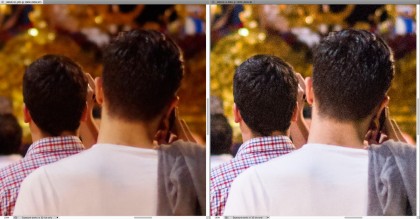
At the time of writing, it’s not possible to open and edit the KS-2’s PEF raw files using Adobe Camera Raw, but the camera can also shoot in DNG format, which is a universal raw format you should be able to open in any software with DNG support.
On the whole, the K-S2’s automatic white balance system copes well with a variety of different light sources. However, at times it can be a little confused some scenarios, such as overcast, dim light. When shooting under artificial lighting, the camera is fairly capable, but it can err towards the warm side. For best accuracy, you can switch to a more appropriate white balance setting, such as Cloudy or Tungsten. Or, if you shoot in raw format, you can change this setting after the event if it hasn’t quite got it right.
 Click here for a full size version.
Click here for a full size version.
In most average situations, the camera’s all-purpose metering system produces good exposures, but a little extra exposure compensation is required every now and then to get a bright, accurately exposed shot when light levels are a little on the dark side, or there’s high contrast.
I’ve seen it before with some Pentax lenses, and it’s a little unfortunate to see it here too, but purple fringing can sometimes be seen around edges in very high contrast situations when using the kit lens. It’s not something that happens with every shot, but it’s a shame to see it occurring at all.
On the plus side, autofocusing is quicker using this camera’s kit lens than the one that accompanied the K-S1. Most of the time it will get the subject in focus quickly and easily, perhaps hunting a little more as light levels drop.
 Click here for a full size version.
Click here for a full size version.
 Click here for a full size version.
Click here for a full size version.
Lab tests: Resolution
We’ve carried out lab tests on the Pentax K-S2 across its full ISO range for resolution, noise (including signal to noise ratio) and dynamic range. We test the JPEGs shot by the camera, but we also check the performance with raw files. Most enthusiasts and pros prefer to shoot raw, and the results can often be quite different.
We’ve also picked out three of its chief rivals so that you can compare their performance directly.
• Canon 700D: Until the new EOS 750D and 760D become available, this is still Canon’s top beginners camera.
• Nikon D5500: Nikon’s most advanced beginners camera impressed us with its resolution.
• Olympus OM-D E-M5 II: It looks and handles just like a DSLR but it’s actually a compact system camera.
Resolution test chart
We test camera resolution using an industry-standard ISO test chart that allows precise visual comparisons. For a full explanation of what our resolution charts mean, and how to read them, check out our camera resolution test process.
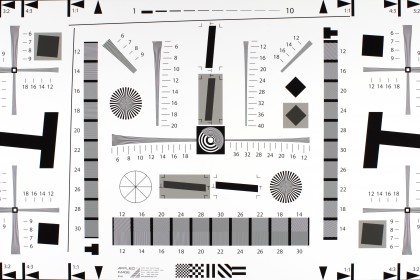
Pentax K-S2 resolution
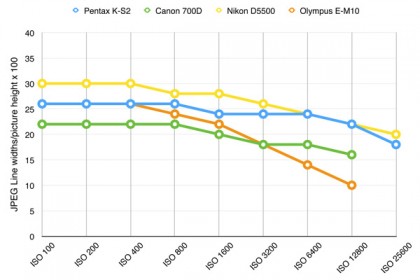
JPEG analysis: The Nikon D5500 has a clear advantage over its rivals right up to ISO 3200, but the Pentax K-S2 and Olympus E-M5 II put in a good performance not far behind. The EOS 700D and its older sensor trail behind except at ISO 3200 and above.
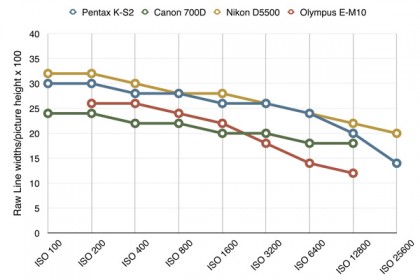
Raw analysis: The K-S2’s raw files show better detail than its JPEGs and it runs the Nikon D5500 a very close second. The E-M5 II is a little behind but it’s still ahead of the EOS 700D.
Lab tests: Dynamic range
Dynamic range is the range of tones the sensor can capture. Cameras with low dynamic range will often show ‘blown’ highlights or blocked-in shadows. This test is carried out in controlled conditions using DxO hardware and analysis tools.
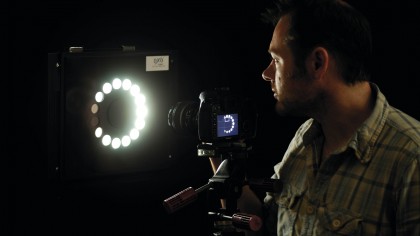
Dynamic range is measured in exposure values (EV). The higher the number the wider the range of brightness levels the camera can capture. This falls off with increasing ISO settings because the camera is having to amplify a weaker signal. Raw files capture a higher dynamic range because the image data is unprocessed.
Pentax K-S2 dynamic range
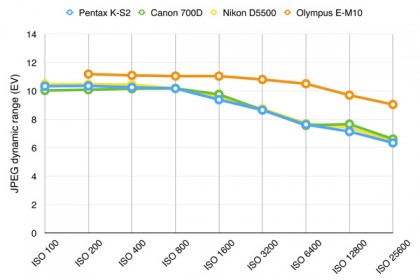
JPEG analysis: Interestingly, the Olympus scores highest here, particularly at higher ISOs. The Pentax K-S2, Canon 700D and Nikon D5500 deliver almost identical results.
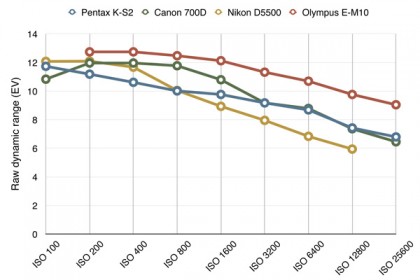
Raw analysis: The pattern changes with raw files, where the E-M5 II still leads but with a smaller margin. The EOS 700D is now second best, while the Nikon D5500 and Pentax K-S2 trade places at different ISOs.
Lab tests: Signal to noise ratio
This is a test of the camera’s noise levels. The higher the signal to noise ratio, the greater the difference in strength between the real image data and random background noise, so the ‘cleaner’ the image will look. The higher the signal to noise ratio, the better.
Pentax K-S2 signal to noise ratio
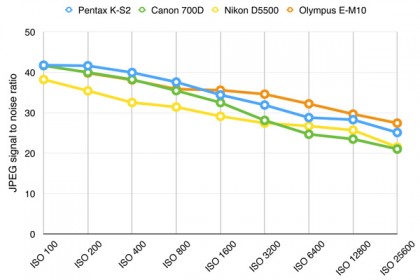
JPEG analysis: The K-S2 delivers similar results to the E-M5 II and EOS 700D right up to ISO 1600 and opens up a slight gap at higher ISOs. It’s clearly better than the Nikon D5500, even though the K-S2 also dispenses with the anti-aliasing effect.
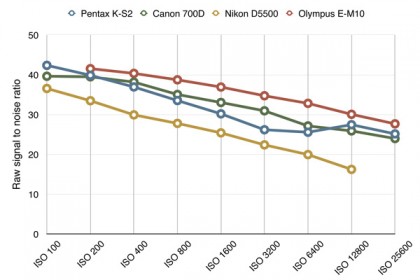
Raw analysis: Here, the Pentax fares slightly less well compared to its rivals. The innate noise levels in its raw files appear to be slightly higher, though it still beats the Nikon D5500.
Verdict
There’s a lot to like about the K-S2. Pentax is offering a good range of functions here for the money, and if you’re not in the Nikon or Canon (or maybe even Sony) camp, then this makes a good alternative. It’s especially good if you’re keen on something small and light, particularly when you consider the lenses for the camera are also on the small side too.
The weatherproofing is fantastic to have, while a 100% viewfinder is unusual in a camera at this level.
It’s taken Pentax a while to include a fully articulating screen, and while it’s not particularly novel any more, it remains useful nevertheless for composing shots from awkward angles, or when you’re shooting movies.
Although it may not be something many people give consideration to, the app which accompanies the K-S2 is also genuinely useful and a delight to use. So many of the wireless remote apps which I use offer little to no control, other than to trip the shutter release, so it’s nice to have one here which gives you full exposure control when you’re controlling remotely.
In use the camera also feels natural, and it doesn’t take too long to get to know its idiosyncrasies, with a good range of external dials and buttons to make settings changes quickly and easily.
Obviously the most important aspect of any camera is its picture quality, and the K-S2 also performs very well here too. Images are nice and bright, and there’s good scope for getting shots exactly how you want them with different Custom Image and Digital Filters etc which give you lots of room for creativity. Being able to shoot in the universal DNG format is also useful for post-production too. Detail is also resolved well thanks to the lack of an anti-aliasing filter.
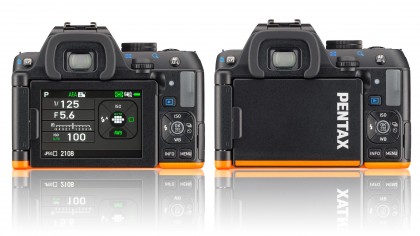
It’s a shame that image quality is brought down a touch by evidence of purple fringing when using the kit lens in some situations, but it’s not something that should plague most everyday shots – it’s just something to keep an eye out for. It’s great that the kit lens itself retracts down to a small size when you’re storing or transporting the camera, but it does mean that the ring for zooming is a little more fiddly – it’s something you get used to with time, though.
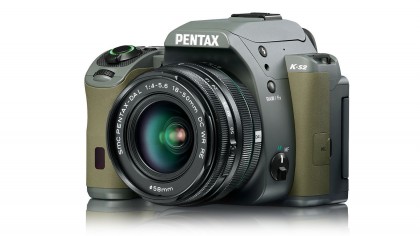
We liked
The overall handling of this camera is great, and it feels very natural to hold. The free Image Sync Wi-Fi app has to be one of the best currently on the market as it gives you pretty much free rein over the camera’s settings, making it genuinely useful for enthusiasts who need to be able to shoot remotely for whatever reason, rather than just being a gimmick for group shots and selfies.
We disliked
In fact, there’s not too much to dislike about this camera, but the evidence of purple fringing when using the kit lens is somewhat disappointing.
Verdict
For those who can’t find a Canon or Nikon camera to suit them, or perhaps those who have vintage Pentax lenses, the K-S2 makes for a fantastic first time DSLR.
With a great feature set, good quality images and a natural way of using it, it’s easy to recommend the K-S2 to a wide range of people.
![]()
Related Posts
December 6, 2021
7+ Web Design Trends for 2022: Which Will You Use?
December 6, 2021
The 10 Best WordPress Booking Plugins to Use On Your Website
December 6, 2021
How to Use a Web Cache Viewer to View a Cached Page
November 6, 2021
10 Modern Web Design Trends for 2022
November 6, 2021
Best Free SSL Certificate Providers (+ How to Get Started)
November 6, 2021
How to Design a Landing Page That Sends Conversions Skyrocketing
November 6, 2021
What Are the Best WordPress Security Plugins for your Website?
October 6, 2021
Your Guide to How to Buy a Domain Name
October 6, 2021
How to Build a WordPress Website: 9 Steps to Build Your Site
September 6, 2021
10 Best Websites for Downloading Free PSD Files
September 6, 2021
HTML5 Template: A Basic Code Template to Start Your Next Project
September 6, 2021
How Much Does It Cost to Build a Website for a Small Business?
September 6, 2021
A List of Free Public CDNs for Web Developers
September 6, 2021
6 Advanced JavaScript Concepts You Should Know
August 6, 2021
10 Simple Tips for Launching a Website
August 6, 2021
25 Beautiful Examples of “Coming Soon” Pages
August 6, 2021
10 Useful Responsive Design Testing Tools
August 6, 2021
Best-Converting Shopify Themes: 4 Best Shopify Themes
July 6, 2021
What Is Alt Text and Why Should You Use It?
July 6, 2021
24 Must-Know Graphic Design Terms
June 6, 2021
How to Design a Product Page: 6 Pro Design Tips
April 6, 2021
A Beginner’s Guide to Competitor Website Analysis
April 6, 2021
6 BigCommerce Design Tips For Big Ecommerce Results
April 6, 2021
Is WordPress Good for Ecommerce? [Pros and Cons]
March 6, 2021
Make Websites Mobile-Friendly: 5 Astounding Tips
March 6, 2021
Shopify vs. Magento: Which Platform Should I Use?
March 6, 2021
Top 5 Web Design Tools & Software Applications
February 6, 2021
Website Optimization Checklist: Your Go-To Guide to SEO
February 6, 2021
5 UX Design Trends to Dazzle Users in 2021
February 6, 2021
What Is the Average Page Load Time and How Can You Do Better?
February 6, 2021
Choosing an Ecommerce Platform That Will Wow Customers
February 6, 2021
7 Best Practices for Crafting Landing Pages with Forms
February 6, 2021
7 B2B Web Design Tips to Craft an Eye-Catching Website
January 6, 2021
Mobile-Friendly Checker | Check Your Site’s Mobile Score Now
January 6, 2021
8 Tips for Developing a Fantastic Mobile-Friendly Website
December 6, 2020
How to Add an Online Store to Your Website [4 Ways]
December 6, 2020
5 UX Design Tips for Seamless Online Shopping
November 6, 2020
Ecommerce Website Essentials: Does Your Site Have All 11?
November 6, 2020
5 Small Business Website Essentials You Need for Your Site
November 6, 2020
Your Website Redesign Checklist for 2020: 7 Steps for Success
May 1, 2020
Psychology of Color [Infographic]
April 21, 2020
How to start an online store that drives huge sales
January 3, 2020
5 Lead Generation Website Design Best Practices
March 6, 2019
6 Reasons You Should Redesign Your Website in 2019
March 6, 2019
7 Web Design Trends for 2019
February 19, 2019
Who owns the website/app source code, client or developer
February 7, 2019
Don’t Let Your Domain Names Expire in 2019
January 8, 2019
2019 Website Development Trends To Note
October 6, 2017
How Web Design Impacts Content Marketing
October 6, 2017
How to Choose a Navigation Setup
August 6, 2017
Why User Experience Matters to Marketing
July 6, 2017
5 Ways Web Design Impacts Customer Experience
September 6, 2016
How to Learn Angular
September 6, 2016
The Excuses for Not Having a Website (Infographic)
September 6, 2016
How to Build an Award-Winning Web Design Team
September 6, 2016
13 Free Data Visualization Tools
August 6, 2016
How Selling Pastries Helped Us Design a Better Product
August 6, 2016
11 Sites to Help You Find Material Design Inspiration
July 4, 2016
How to change free wordpress.com url
April 6, 2016
The 5 Best Free FTP Clients
April 6, 2016
7 Free UX E-Books Worth Reading
March 6, 2016
Can Handwritten Letters Get You More Clients?
December 10, 2015
Star Wars Week: How to create your own Star Wars effects for free
December 6, 2015
20 "Coming Soon" Pages for Inspiration
December 6, 2015
6 Free Tools for Creating Your Own Icon Font
December 6, 2015
9 Useful Tools for Creating Material Design Color Palettes
November 6, 2015
20 Free UI Kits to Download
November 6, 2015
50 Web Designs with Awesome Typography
November 6, 2015
When to Use rel="nofollow"
November 6, 2015
7 Free Books That Will Help You Become More Productive
November 6, 2015
50 Beautiful One-Page Websites for Inspiration
November 6, 2015
Circular Images with CSS
October 6, 2015
Lessons Learned from an Unsuccessful Kickstarter
October 6, 2015
5 Games That Teach You How to Code
October 6, 2015
Cheatsheet: Photoshop Keyboard Shortcuts
October 6, 2015
An Easy Way to Create a Freelance Contract for Your Projects
October 6, 2015
50 Design Agency Websites for Inspiration
September 29, 2015
JB Hi-Fi shutting the book on ebooks
September 24, 2015
Opinion: Quick, Quickflix: It's time to give yourself the flick
September 24, 2015
New Star Wars 360-degree video is among first on Facebook
September 21, 2015
Apple purges malicious iPhone and iPad apps from App Store
September 12, 2015
Apple's new Live Photos feature will eat up your storage
September 12, 2015
The latest Windows 10 Mobile preview has been delayed
September 12, 2015
IBM buys StrongLoop to add Node.js development to its cloud
September 8, 2015
Fake Android porn app takes your photo, then holds it ransom
September 6, 2015
50 Restaurant Websites for Inspiration
September 6, 2015
Zero UI — The Future of Interfaces
September 6, 2015
50 Beautiful Websites with Big Background Images
September 6, 2015
Infographic: 69 Web Design Tips
September 6, 2015
Free Windows 10 Icons
September 2, 2015
Instagram turns itself into a genuine messaging service
August 11, 2015
In Depth: How Microsoft taught Cortana to be more human
August 11, 2015
Windows 10 price, news and features
August 11, 2015
Windows 10's broken update introduces endless reboot loop
August 11, 2015
Windows 10 races to 27m installs
August 11, 2015
Windows 10 IoT Core gets first public release
August 10, 2015
iOS Tips: How to backup iPhone to an external drive
August 10, 2015
Windows 8.1 RT finally getting Windows 10 Start Menu
August 10, 2015
How to use Windows Hello
August 10, 2015
Review: Moto Surround
August 10, 2015
Review: Moto G (2015)
August 9, 2015
8 of the best free VPN services
August 8, 2015
Use Firefox? Mozilla urges you update ASAP
August 7, 2015
Mac Tips: Apple Mail: How to remove the Favorites Bar
August 7, 2015
How to make the OS X dock appear faster
August 7, 2015
Review: BQ Aquaris E45 Ubuntu Edition
August 7, 2015
Review: Acer Liquid Jade Z
August 6, 2015
How to reinstall Linux
August 6, 2015
How to reinstall Windows
August 6, 2015
Updated: Apple Music: release date, price and features
August 6, 2015
Social News Websites for Front-End Developers
August 6, 2015
10 Free JavaScript Books
August 6, 2015
50 Beautiful Blog Designs
August 6, 2015
Animated SVG Pipes Effect
August 6, 2015
Launching Your First App
August 5, 2015
Windows 10 goes freemium with paid apps
August 5, 2015
Updated: Week 1 with Windows 10
August 5, 2015
Mac Tips: How to manage Safari notifications on Mac
August 5, 2015
Microsoft Sway may kill the PowerPoint presentation
August 4, 2015
Microsoft gives Outlook on the web a new look
August 4, 2015
Mac OS X vulnerable to new zero-day attack
August 4, 2015
Windows 10 users warned of two scams
August 4, 2015
Microsoft's Docs.com is now available to everyone
August 3, 2015
Mac Tips: How to edit the Favorites sidebar on Mac
August 3, 2015
Updated: Windows 10 price, news and features
July 29, 2015
Review: HP ProDesk 405 G2
July 29, 2015
Hands-on review: HP Elite x2 1011
July 29, 2015
Hands-on review: Updated: Windows 10 Mobile
July 29, 2015
Review: Updated: Nvidia Shield Android TV
July 28, 2015
LIVE: Windows 10 launch: Live Blog!
July 28, 2015
How to prepare for your upgrade to Windows 10
July 28, 2015
Review: Updated: Windows 10
July 28, 2015
Review: Updated: HP Pro Tablet 608
July 28, 2015
Review: Heat Genius
July 28, 2015
Hands-on review: Moto X Play
July 28, 2015
Hands-on review: Moto X Style
July 28, 2015
Hands-on review: Moto G (2015)
July 28, 2015
Review: 13-inch MacBook Air (early 2015)
July 28, 2015
Hands-on review: OnePlus 2
July 28, 2015
Review: LG 65EG960T 4K OLED
July 28, 2015
Mac Tips: How to share printers on Mac
July 27, 2015
Apple Music's arrival hasn't opened Pandora's box
July 26, 2015
Review: Garmin Swim
July 25, 2015
How to merge OS X contacts into an existing list
July 25, 2015
Hands-on review: UPDATED: ZTE Axon
July 24, 2015
Mac Tips: How to zoom in on a Mac
July 24, 2015
What Windows 10 means for the enterprise
July 24, 2015
Review: JBL Charge 2 Plus
July 24, 2015
Review: Acer Aspire S7
July 24, 2015
Review: Updated: Canon G3 X
July 24, 2015
Review: Updated: iPad Air 2
July 24, 2015
Review: Thinksound On1
July 24, 2015
Review: Asus Chromebook Flip
July 24, 2015
Review: Garmin Forerunner 225
July 23, 2015
Review: Garmin nuvi 68LM
July 23, 2015
Review: Samsung Galaxy S6 Active
July 23, 2015
Review: Bowers and Wilkins P5 Wireless
July 23, 2015
Review: Dell XPS 15 (2015)
July 21, 2015
Review: Fuji S9900W
July 21, 2015
Review: Updated: Fitbit Surge
July 21, 2015
Review: UE Roll
July 21, 2015
Hands-on review: Ubik Uno
July 20, 2015
Review: Samsung HW-J650
July 20, 2015
Updated: 40 best Android Wear smartwatch apps 2015
July 20, 2015
Review: Acer Chromebook C740 review
July 20, 2015
Review: Huawei Talkband B2
July 20, 2015
Review: Dell Venue 10 7000
July 20, 2015
Review: Intel Core i7-5775C
July 17, 2015
Mac Tips: How to delete locked files on Mac
July 17, 2015
Review: Pebble Time
July 16, 2015
Microsoft just made Windows XP even less secure
July 16, 2015
Windows 8.1 RT is getting an update this September
July 16, 2015
OS showdown: Windows 10 vs Windows 8.1 vs Windows 7
July 16, 2015
Review: Acer CB280HK
July 15, 2015
Windows 10 is ready for new laptops and PCs
July 15, 2015
Explained: How to take a screenshot in Windows
July 15, 2015
Office for Windows 10 appears in latest build
July 14, 2015
Review: ZTE Axon
July 14, 2015
Review: ViewSonic VP2780-4K
July 14, 2015
Hands-on review: SanDisk Connect Wireless Stick
July 14, 2015
Review: Oppo PM-3
July 14, 2015
Review: BT 11ac Dual-Band Wi-Fi Extender 1200
July 14, 2015
Review: Fuji X-T10
July 13, 2015
How to build an SEO strategy for your business
July 13, 2015
Review: Lenovo ThinkPad Yoga 15
July 13, 2015
Review: Audio-Technica ATH-MSR7
July 13, 2015
Review: Garmin NuviCam LMT-D
July 13, 2015
Review: Dell Inspiron 13 7000
July 13, 2015
Hands-on review: AstroPi SenseHAT
July 13, 2015
Hands-on review: EE Rook
July 13, 2015
Hands-on review: Updated: HTC Vive
July 12, 2015
Here's the ultimate software list for PC fanatics
July 10, 2015
How to use the new Photos app for Mac
July 10, 2015
Windows 10 Insider Preview Build 10166 available now
July 10, 2015
Splunk spends big on cybersecurity acquisition
July 10, 2015
Making Windows 10 apps just got a whole lot easier
July 10, 2015
Review: Lenovo LaVie Z 360
July 9, 2015
OS X El Capitan public beta available right now
July 9, 2015
Microsoft finally unveils Office 2016 for Mac
July 9, 2015
Review: Updated: Chromecast
July 9, 2015
Review: Updated: Tesco Hudl 2
July 9, 2015
Review: Lenovo ThinkPad E550
July 9, 2015
Review: Updated: Google Nexus 6
July 8, 2015
What you need to know about Windows Server 2016
July 7, 2015
Microsoft to hike enterprise cloud pricing
July 6, 2015
Hacking Team end up being totally 0wned
July 6, 2015
Review: HP Pro Slate 12
July 6, 2015
Review: Samsung 850 Pro 2TB
July 6, 2015
Review: Asus RT-AC87U
July 6, 2015
Review: Jawbone UP2
July 6, 2015
Reimagining the Web Design Process
July 6, 2015
50 Clean Websites for Inspiration
July 6, 2015
15 Free Books for People Who Code
July 6, 2015
Web Storage: A Primer
July 6, 2015
A Look at Some CSS Methodologies
July 3, 2015
6 Essential Mac Mouse and Trackpad Tips
July 2, 2015
How to install a third party keyboard on Android
July 2, 2015
Review: UPDATED: Asus Zenfone 2
July 2, 2015
Review: Alienware 13
July 2, 2015
Review: HP DeskJet 1010
July 1, 2015
5 issues we want Apple Music to fix
June 13, 2015
Cortana will get its own button on Windows 10 PCs
June 12, 2015
Windows 10 will come with universal Skype app
June 12, 2015
iPad music production: 18 Best apps and gear
June 12, 2015
Windows 10 all set for early enterprise struggle
June 12, 2015
Review: Garmin VIRB Elite
June 11, 2015
Review: Updated: Nvidia Shield Tablet
June 11, 2015
Review: Nokia Lumia 635
June 10, 2015
Microsoft brings more online tweaks to Office 365
June 10, 2015
Mac Tips: How to use Screen Sharing in Mac OS X
June 9, 2015
Hands-on review: Meizu M2 Note
June 9, 2015
Hands-on review: EE 4GEE Action Camera
June 9, 2015
Review: Toshiba 3TB Canvio external hard drive
June 9, 2015
Review: Olympus SH-2
June 8, 2015
Hands-on review: Updated: Apple CarPlay
June 8, 2015
UPDATED: iOS 9 release date, features and news
June 8, 2015
Review: Updated: Roku 2
June 8, 2015
Review: Updated: PlayStation Vue
June 8, 2015
Review: Dell PowerEdge R730
June 8, 2015
Review: Canon SX710 HS
June 7, 2015
UPDATED: iOS 9 release date, features and rumors
June 7, 2015
Review: Lenovo S20-30
June 6, 2015
Free Writing Icons
June 6, 2015
15 CSS Questions to Test Your Knowledge
June 6, 2015
The Best CSS Reset Stylesheets
June 6, 2015
How CSS Specificity Works
June 5, 2015
'Delay' is a new feature in Windows 10
June 5, 2015
Review: Beyerdynamic Custom One Pro Plus
June 5, 2015
Latest SEO Marketing tools
June 5, 2015
Review: Nvidia Shield Android TV
June 5, 2015
Review: Honor 4X
June 5, 2015
Review: In Depth: Oppo R5
June 3, 2015
Hands-on review: Huawei P8 Lite
June 3, 2015
How To: How to create eBooks on a Mac
June 3, 2015
Review: Updated: Tidal
June 3, 2015
Review: Canon 750D (Rebel T6i)
June 2, 2015
Review: Updated: Asus ZenWatch
June 2, 2015
Review: Alcatel OneTouch Idol 3
June 2, 2015
Review: Updated: Nokia Lumia 1520
June 2, 2015
Review: Updated: Yotaphone 2
June 2, 2015
Review: Updated: Nokia Lumia 625
June 2, 2015
Review: Creative Muvo Mini
June 1, 2015
Review: Acer TravelMate P645 (2015)
June 1, 2015
Hands-on review: Corsair Bulldog
May 29, 2015
In Depth: NetApp: a requiem
May 29, 2015
July is looking definite for Windows 10 release
May 29, 2015
Hands-on review: Google Photos
May 28, 2015
Mac Tips: The 16 best free GarageBand plugins
May 28, 2015
Review: Canon 760D (Rebel T6s)
May 27, 2015
Review: Lenovo Yoga 3 14
May 27, 2015
Hands-on review: Serif Affinity Photo
May 27, 2015
Review: Garmin Vivoactive
May 26, 2015
Review: Datacolor Spyder5 Elite
May 26, 2015
Hands-on review: Sony Xperia Z3+
May 26, 2015
Review: Epson BrightLink Pro 1410Wi
May 26, 2015
Review: Technics Premium C700
May 26, 2015
Review: Canon EOS M3
May 26, 2015
Review: Updated: HTC One M9
May 26, 2015
Review: Updated: Sony Xperia Z3 Compact
May 25, 2015
Review: Updated: New Nintendo 3DS
May 25, 2015
Updated: 50 best Mac tips, tricks and timesavers
May 25, 2015
Updated: Windows email: 5 best free clients
May 25, 2015
Instagram is planning to invade your inbox
May 25, 2015
Review: Updated: Foxtel Play
May 24, 2015
How Windows 10 will change smartphones forever
May 24, 2015
Review: Vodafone Smart Prime 6
May 24, 2015
Review: Updated: iPad mini
May 22, 2015
Office Now may be Cortana for your work life
May 22, 2015
Review: Updated: Lenovo Yoga 3 Pro
May 22, 2015
Review: Microsoft Lumia 640 LTE
May 22, 2015
Review: Updated: Fitbit Flex
May 21, 2015
Updated: Best free Android apps 2015
May 21, 2015
Review: Asus ZenBook Pro UX501
May 21, 2015
Review: Sennheiser Momentum In-Ear
May 20, 2015
Hands-on review: UPDATED: Asus Zenfone 2
May 20, 2015
OS X 10.11 release date, features and rumors
May 18, 2015
Updated: Best free antivirus software 2015
May 18, 2015
iPhone 6S rumored to launch as soon as August
May 18, 2015
Microsoft ready to pounce and acquire IFS?
May 17, 2015
5 of the most popular Linux gaming distros
May 16, 2015
Review: Acer Chromebook 15 C910
May 16, 2015
Review: Lenovo ThinkPad X1 Carbon (2015)
May 16, 2015
Review: Polk Nue Voe
May 16, 2015
The top 10 data breaches of the past 12 months
May 16, 2015
Hands-on review: Updated: LG G4
May 16, 2015
Review: Updated: Quickflix
May 16, 2015
Review: LG Watch Urbane
May 16, 2015
Review: Razer Nabu X
May 16, 2015
Hands-on review: Updated: Windows 10
May 16, 2015
Review: UPDATED: Moto X
May 16, 2015
Review: Updated: Moto G (2013)
May 12, 2015
Review: TomTom Go 50
May 12, 2015
Review: Updated: Moto G (2014)
May 12, 2015
Review: Garmin Vivofit 2
May 12, 2015
Review: Asus Transformer Book Flip TP300LA
May 11, 2015
Review: MSI GT80 Titan
May 11, 2015
Review: Monster SuperStar BackFloat
May 9, 2015
Review: Updated: Apple Watch
May 7, 2015
5 million internet users infected by adware
May 7, 2015
Review: Updated: New MacBook 2015
May 6, 2015
Android M will be shown at Google IO 2015
May 6, 2015
Review: Epson WorkForce Pro WF-4630
May 6, 2015
Review: Master & Dynamic MH40
May 6, 2015
How to Use Gulp
May 6, 2015
Getting Started with Command-Line Interfaces
May 6, 2015
What It’s Like to Contribute to WordPress
May 6, 2015
Ultimate Guide to Link Types for Hyperlinks
May 6, 2015
11 Things You Might Not Know About jQuery
May 5, 2015
Hands-on review: Updated: PlayStation Now
May 5, 2015
Review: Lenovo ThinkPad Yoga 12
May 5, 2015
Review: Updated: iPad Air
May 5, 2015
Review: Panasonic SZ10
May 5, 2015
Review: Updated: Fetch TV
May 4, 2015
Review: Cambridge Audio Go V2
May 3, 2015
Review: Lightroom CC/Lightroom 6
May 2, 2015
5 of the most popular Raspberry Pi distros
May 1, 2015
Review: PlayStation Vue
May 1, 2015
Hands-on review: Updated: Microsoft HoloLens
April 30, 2015
Build 2015: Why Windows 10 may not arrive until fall
April 29, 2015
The biggest announcements from Microsoft Build 2015
April 29, 2015
Hands-on review: TomTom Bandit
April 29, 2015
Hands-on review: EE Harrier Mini
April 28, 2015
Review: Samsung NX500
April 28, 2015
Hands-on review: LG G4
April 28, 2015
Review: Patriot Ignite 480GB SSD
April 28, 2015
Hands-on review: EE Harrier
April 28, 2015
Review: Linx 10
April 28, 2015
Review: 1&1 Cloud Server
April 26, 2015
Hands-on review: Acer Iconia One 8
April 25, 2015
How to run Windows on a Mac with Boot Camp
April 24, 2015
Dropbox Notes poised to challenge Google Docs at launch
April 24, 2015
Hands-on review: Acer Aspire E14
April 24, 2015
Hands-on review: UPDATED: Valve Steam Controller
April 24, 2015
Review: Acer Iconia One 7
April 23, 2015
Windows 10 just revived everyone's favorite PC game
April 23, 2015
Google opens up Chromebooks to competitors
April 23, 2015
Here's how Outlook 2016 looks on Windows 10
April 23, 2015
Hands-on review: Updated: Acer Liquid M220
April 23, 2015
Hands-on review: Acer Aspire Switch 10 (2015)
April 23, 2015
Hands-on review: Acer Aspire R 11
April 22, 2015
Review: Alienware 17 (2015)
April 22, 2015
Hands-on review: Updated: HP Pavilion 15 (2015)
April 21, 2015
This is how Windows 10 will arrive on your PC
April 21, 2015
Review: iMac with Retina 5K display
April 21, 2015
Review: Epson XP-420 All-in-One
April 18, 2015
Google Now brings better search to Chrome OS
April 17, 2015
Review: Epson Moverio BT-200
April 16, 2015
Updated: Android Lollipop 5.0 update: when can I get it?
April 15, 2015
Hands-on review: Updated: Huawei P8
April 15, 2015
Review: SanDisk Ultra Dual USB Drive 3.0
April 15, 2015
Review: Updated: LG G3
April 15, 2015
Review: Updated: LG G3
April 15, 2015
Review: Crucial BX100 1TB
April 13, 2015
iOS 8.4 beta reveals complete Music app overhaul
April 13, 2015
Linux 4.0: little fanfare for a tiny new release
April 13, 2015
Achievement unlocked: Microsoft gamifies Windows 10
April 13, 2015
Best Android Wear smartwatch apps 2015
April 13, 2015
Review: Acer Aspire R13
April 12, 2015
Review: TP-Link Archer D9
April 10, 2015
Microsoft's new browser arrives for Windows 10 phones
April 10, 2015
Review: LG UltraWide 34UC97
April 9, 2015
Office now integrates with Dropbox on the web
April 9, 2015
Now you can buy video games with Apple Pay
April 9, 2015
Updated: iOS 8 features and updates
April 9, 2015
Microsoft's stripped down Nano Server is on the way
April 8, 2015
Skype Translator gets even more features
April 8, 2015
Windows mail services hit by widespread outages
April 8, 2015
Review: UPDATED: Amazon Echo
April 8, 2015
Hands-on review: Dell Venue 10 7000
April 8, 2015
Review: Updated: OS X 10.10 Yosemite
April 7, 2015
Google's GMeet could kill teleconferencing
April 7, 2015
Is Redstone the first Windows 10 update?
April 7, 2015
Next peek at Windows Server 2016 due next month
April 7, 2015
Review: Acer Aspire Switch 11
April 7, 2015
Review: Adobe Document Cloud
April 6, 2015
Hands-on review: Updated: New MacBook 2015
April 6, 2015
Freebie: 100 Awesome App Icons
April 6, 2015
Six Revisions Quarterly Report #1
April 6, 2015
A Modern Approach to Improving Website Speed
April 6, 2015
Disable Text Selection with CSS
April 4, 2015
Review: Nikon D7200
April 3, 2015
Amazon Prime video now streams to any Android tablet
April 3, 2015
Review: Google Cardboard
April 3, 2015
Review: MSI WS60
April 2, 2015
Chrome users can now run 1.3 million Android apps
April 2, 2015
See Windows 10 Mobile running on an Android handset
April 2, 2015
Review: Mini review: Macphun Noiseless Pro 1.0
April 2, 2015
Review: Intel SSD 750 Series 1.2TB
April 2, 2015
Review: BenQ TreVolo
April 2, 2015
Hands-on review: Nikon 1 J5
April 1, 2015
Microsoft launches Windows 10 music and video apps
April 1, 2015
Review: mini review: Sony XBA-H1
December 19, 2014
Review: CoPilot Premium sat nav app
December 19, 2014





























































































































































































































































































































































































































































































































































































